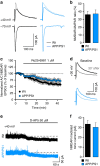Early synaptic deficits in the APP/PS1 mouse model of Alzheimer's disease involve neuronal adenosine A2A receptors
- PMID: 27312972
- PMCID: PMC4915032
- DOI: 10.1038/ncomms11915
Early synaptic deficits in the APP/PS1 mouse model of Alzheimer's disease involve neuronal adenosine A2A receptors
Abstract
Synaptic plasticity in the autoassociative network of recurrent connections among hippocampal CA3 pyramidal cells is thought to enable the storage of episodic memory. Impaired episodic memory is an early manifestation of cognitive deficits in Alzheimer's disease (AD). In the APP/PS1 mouse model of AD amyloidosis, we show that associative long-term synaptic potentiation (LTP) is abolished in CA3 pyramidal cells at an early stage. This is caused by activation of upregulated neuronal adenosine A2A receptors (A2AR) rather than by dysregulation of NMDAR signalling or altered dendritic spine morphology. Neutralization of A2AR by acute pharmacological inhibition, or downregulation driven by shRNA interference in a single postsynaptic neuron restore associative CA3 LTP. Accordingly, treatment with A2AR antagonists reverts one-trial memory deficits. These results provide mechanistic support to encourage testing the therapeutic efficacy of A2AR antagonists in early AD patients.
Conflict of interest statement
The authors declare no competing financial interests.
Figures







Similar articles
-
Blockade of adenosine A2A receptors reverses early spatial memory defects in the APP/PS1 mouse model of Alzheimer's disease by promoting synaptic plasticity of adult-born granule cells.Alzheimers Res Ther. 2023 Oct 30;15(1):187. doi: 10.1186/s13195-023-01337-z. Alzheimers Res Ther. 2023. PMID: 37899431 Free PMC article.
-
Blockade of adenosine A2A receptors recovers early deficits of memory and plasticity in the triple transgenic mouse model of Alzheimer's disease.Neurobiol Dis. 2018 Sep;117:72-81. doi: 10.1016/j.nbd.2018.05.024. Epub 2018 May 31. Neurobiol Dis. 2018. PMID: 29859867
-
Neuronal A2A receptor exacerbates synapse loss and memory deficits in APP/PS1 mice.Brain. 2024 Aug 1;147(8):2691-2705. doi: 10.1093/brain/awae113. Brain. 2024. PMID: 38964748 Free PMC article.
-
A2A Adenosine Receptor Antagonists in Neurodegenerative Diseases.Curr Med Chem. 2022;29(24):4138-4151. doi: 10.2174/0929867328666211129122550. Curr Med Chem. 2022. PMID: 34844537 Free PMC article. Review.
-
Targeting synaptic dysfunction in Alzheimer's disease therapy.Mol Neurobiol. 2012 Dec;46(3):572-87. doi: 10.1007/s12035-012-8324-3. Epub 2012 Aug 23. Mol Neurobiol. 2012. PMID: 22914888 Review.
Cited by
-
Acetylation of AMPA Receptors Regulates Receptor Trafficking and Rescues Memory Deficits in Alzheimer's Disease.iScience. 2020 Aug 15;23(9):101465. doi: 10.1016/j.isci.2020.101465. eCollection 2020 Sep 25. iScience. 2020. PMID: 32861999 Free PMC article.
-
Caffeine Functions by Inhibiting Dorsal and Ventral Hippocampal Adenosine 2A Receptors to Modulate Memory and Anxiety, Respectively.Front Pharmacol. 2022 Feb 2;13:807330. doi: 10.3389/fphar.2022.807330. eCollection 2022. Front Pharmacol. 2022. PMID: 35185566 Free PMC article.
-
Brain activity during a working memory task after daily caffeine intake and caffeine withdrawal: a randomized double-blind placebo-controlled trial.Sci Rep. 2023 Jan 18;13(1):1002. doi: 10.1038/s41598-022-26808-5. Sci Rep. 2023. PMID: 36653409 Free PMC article. Clinical Trial.
-
Early alterations in hippocampal perisomatic GABAergic synapses and network oscillations in a mouse model of Alzheimer's disease amyloidosis.PLoS One. 2019 Jan 15;14(1):e0209228. doi: 10.1371/journal.pone.0209228. eCollection 2019. PLoS One. 2019. PMID: 30645585 Free PMC article.
-
Mitochondrial Deficits With Neural and Social Damage in Early-Stage Alzheimer's Disease Model Mice.Front Aging Neurosci. 2021 Dec 10;13:748388. doi: 10.3389/fnagi.2021.748388. eCollection 2021. Front Aging Neurosci. 2021. PMID: 34955809 Free PMC article.
References
-
- Sperling R. Functional MRI studies of associative encoding in normal aging, mild cognitive impairment, and Alzheimer's disease. Ann. N. Y. Acad. Sci. 1097, 146–155 (2007). - PubMed
-
- Selkoe D. J. Alzheimer's disease is a synaptic failure. Science 298, 789–791 (2002). - PubMed
-
- Nakazawa K. et al. Hippocampal CA3 NMDA receptors are crucial for memory acquisition of one-time experience. Neuron 38, 305–315 (2003). - PubMed
-
- Rolls E. T. & Treves A. The neuronal encoding of information in the brain. Prog. Neurobiol. 95, 448–490 (2011). - PubMed
Publication types
MeSH terms
Substances
LinkOut - more resources
Full Text Sources
Other Literature Sources
Medical
Molecular Biology Databases
Miscellaneous

